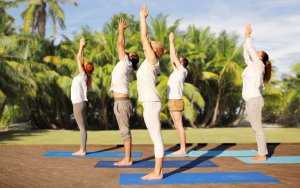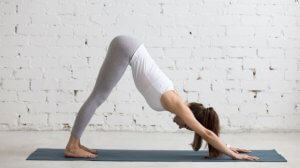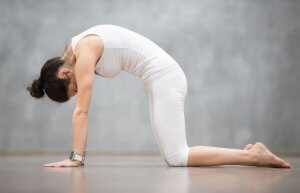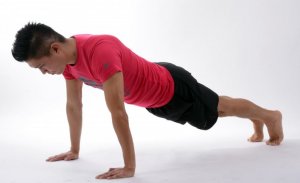Easy Positions To Get Started In Yoga

Yoga is a fantastic activity to improve your posture, exercise your muscles and reduce stress through techniques such as meditation. It’s a space of deep connection with your body. If you’re thinking about giving it a try, here are some simple positions to start with, so that you can gain practice in this discipline.
If you’re in search of a physical activity that promotes your well-being and helps you to relax, yoga is a great option. In case you’ve never tried it, you can start at home with some of these initiation positions that we detail in this article.
Yoga’s health benefits

Doing yoga can bring enormous benefits to your health. Here are just some of them:
- Increase your flexibility
- Improve your posture
- Stimulate your concentration
- Induce weight loss
- Improve your quality of rest
- Increase your inner peace and emotional balance
- Help you to breathe correctly
- Reduce stress
- Enhance your well-being and sex life
- Fight depression
In addition, there are many different types of yoga disciplines available. Because of this, yoga can be adapted to people with different physical abilities and with more or less developed capabilities. A very innovative kind is facial yoga, a variant designed to relax your face.
Simple yoga postures
Next, we’ll talk about some yoga exercises that you can practice at home. If you like them and you want to know more about them, don’t hesitate to sign up for a yoga class near you, and discover your full potential.
Swaying palm tree pose
Stand with your feet slightly apart for stability, with your big toes almost touching. Keep your spine straight and raise your arms above your head; point them all the way up and keep them parallel to each other.
With your palms inwards, stretch your body, push out your chest and look straight ahead. Breathe five times and then intertwine your fingers and turn your palms towards the ceiling.
Take a deep breath and, while trying to keep your balance, lean to the right. You will feel your left side stretching out. Then, lean towards the other side. Once you do this, return to the center and resume the initial position.
Downward dog pose

It’s one of the basic positions for those who are just getting started in this discipline. To do it, stand up and start leaning your body forward; until you place your hands and feet on the floor. Always keep your arms and legs shoulder-width apart.
The point of support for the palms of your hands, should be as close as possible to your feet. Remember to always keep your hips lifted and stay in this position for several deep breaths.
If you want to add some difficulty, try to extend one foot backwards. Therefore, your arms, the core of your body and the leg you’re extending, should be in a straight line.
Butterfly pose
This is one of the easiest positions to get started with in yoga. Start by sitting with your back straight and your legs stretched out. Separate them a little, and bend in your knees to bring your feet close to your pelvis. Join the soles of your feet.
Then, push out your chest and grab your feet with your hands. Holding your feet firmly, move your legs (as if they were the wings of a butterfly) for 30 seconds. Breathe deeply and, every time you exhale, lean forward bending at the waist, but without bending your back. Once the exercise is done, stay 30 more seconds in the initial position and breathe deeply.
Cat cow pose

Place your hands and knees on the floor. Then, raise your back arching it and tucking your tummy inward. While you’re doing it, duck your head. This is the cat pose.
The cow pose consists of doing the exact opposite: from the initial position, elevate your pelvis and head to look upwards. Push your chest down and lift your tailbone, but always keep your back straight.
Plank pose

Generally, this is done after or before the downward dog pose. It consists of lying face down, using only your hands and the tips of your toes as a support for your weight. Your legs, back and neck should be in a straight line.
Keep this position for ten or fifteen seconds. The key is to build strength with your core muscles, so that your hips don’t lift up, or sink down.
If it’s too hard for you, another way to do this is by resting your knees on the floor.
Avoid common mistakes when you start doing yoga
Finally, before you start practicing yoga -both at home and in private classes- it’s recommended that you consider some useful tips.
The first one, is to find a space and a group of people with whom you feel comfortable. This is fundamental when you want to fully devote yourself to breathing and meditation techniques. In addition, it’s equally important to not compare yourself with other people. Each person moves at their own rhythm and yoga isn’t a competition.
On the other hand, you should always warm up before you start your yoga session. This is because activation exercises will help you to prevent injuries. Don’t despair about doing difficult positions hastily or risk exposing yourself to injuries and pain by going over your limit. Everything should be done in its own time.
Yoga is an excellent physical activity for our integral well-being. You’ll experience new sensations and you will be surprised by what your body is capable of. Don’t hesitate to give it a try!
Yoga is a fantastic activity to improve your posture, exercise your muscles and reduce stress through techniques such as meditation. It’s a space of deep connection with your body. If you’re thinking about giving it a try, here are some simple positions to start with, so that you can gain practice in this discipline.
If you’re in search of a physical activity that promotes your well-being and helps you to relax, yoga is a great option. In case you’ve never tried it, you can start at home with some of these initiation positions that we detail in this article.
Yoga’s health benefits

Doing yoga can bring enormous benefits to your health. Here are just some of them:
- Increase your flexibility
- Improve your posture
- Stimulate your concentration
- Induce weight loss
- Improve your quality of rest
- Increase your inner peace and emotional balance
- Help you to breathe correctly
- Reduce stress
- Enhance your well-being and sex life
- Fight depression
In addition, there are many different types of yoga disciplines available. Because of this, yoga can be adapted to people with different physical abilities and with more or less developed capabilities. A very innovative kind is facial yoga, a variant designed to relax your face.
Simple yoga postures
Next, we’ll talk about some yoga exercises that you can practice at home. If you like them and you want to know more about them, don’t hesitate to sign up for a yoga class near you, and discover your full potential.
Swaying palm tree pose
Stand with your feet slightly apart for stability, with your big toes almost touching. Keep your spine straight and raise your arms above your head; point them all the way up and keep them parallel to each other.
With your palms inwards, stretch your body, push out your chest and look straight ahead. Breathe five times and then intertwine your fingers and turn your palms towards the ceiling.
Take a deep breath and, while trying to keep your balance, lean to the right. You will feel your left side stretching out. Then, lean towards the other side. Once you do this, return to the center and resume the initial position.
Downward dog pose

It’s one of the basic positions for those who are just getting started in this discipline. To do it, stand up and start leaning your body forward; until you place your hands and feet on the floor. Always keep your arms and legs shoulder-width apart.
The point of support for the palms of your hands, should be as close as possible to your feet. Remember to always keep your hips lifted and stay in this position for several deep breaths.
If you want to add some difficulty, try to extend one foot backwards. Therefore, your arms, the core of your body and the leg you’re extending, should be in a straight line.
Butterfly pose
This is one of the easiest positions to get started with in yoga. Start by sitting with your back straight and your legs stretched out. Separate them a little, and bend in your knees to bring your feet close to your pelvis. Join the soles of your feet.
Then, push out your chest and grab your feet with your hands. Holding your feet firmly, move your legs (as if they were the wings of a butterfly) for 30 seconds. Breathe deeply and, every time you exhale, lean forward bending at the waist, but without bending your back. Once the exercise is done, stay 30 more seconds in the initial position and breathe deeply.
Cat cow pose

Place your hands and knees on the floor. Then, raise your back arching it and tucking your tummy inward. While you’re doing it, duck your head. This is the cat pose.
The cow pose consists of doing the exact opposite: from the initial position, elevate your pelvis and head to look upwards. Push your chest down and lift your tailbone, but always keep your back straight.
Plank pose

Generally, this is done after or before the downward dog pose. It consists of lying face down, using only your hands and the tips of your toes as a support for your weight. Your legs, back and neck should be in a straight line.
Keep this position for ten or fifteen seconds. The key is to build strength with your core muscles, so that your hips don’t lift up, or sink down.
If it’s too hard for you, another way to do this is by resting your knees on the floor.
Avoid common mistakes when you start doing yoga
Finally, before you start practicing yoga -both at home and in private classes- it’s recommended that you consider some useful tips.
The first one, is to find a space and a group of people with whom you feel comfortable. This is fundamental when you want to fully devote yourself to breathing and meditation techniques. In addition, it’s equally important to not compare yourself with other people. Each person moves at their own rhythm and yoga isn’t a competition.
On the other hand, you should always warm up before you start your yoga session. This is because activation exercises will help you to prevent injuries. Don’t despair about doing difficult positions hastily or risk exposing yourself to injuries and pain by going over your limit. Everything should be done in its own time.
Yoga is an excellent physical activity for our integral well-being. You’ll experience new sensations and you will be surprised by what your body is capable of. Don’t hesitate to give it a try!
This text is provided for informational purposes only and does not replace consultation with a professional. If in doubt, consult your specialist.








